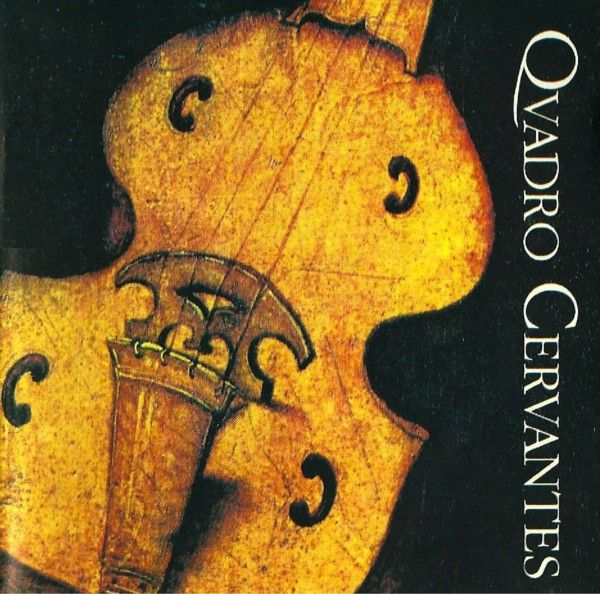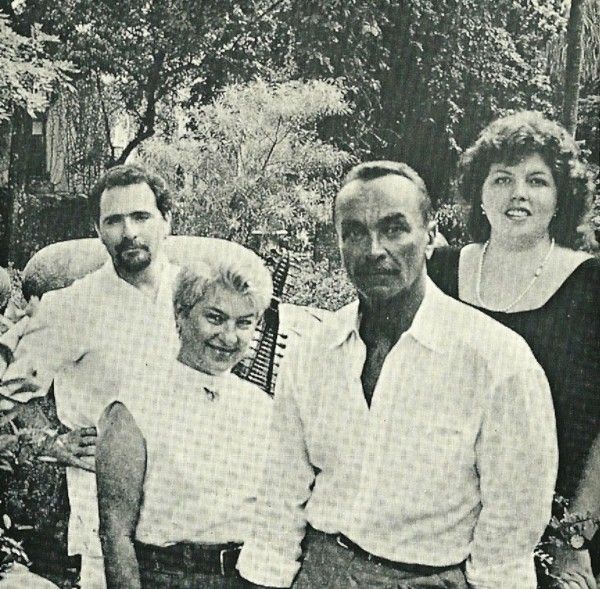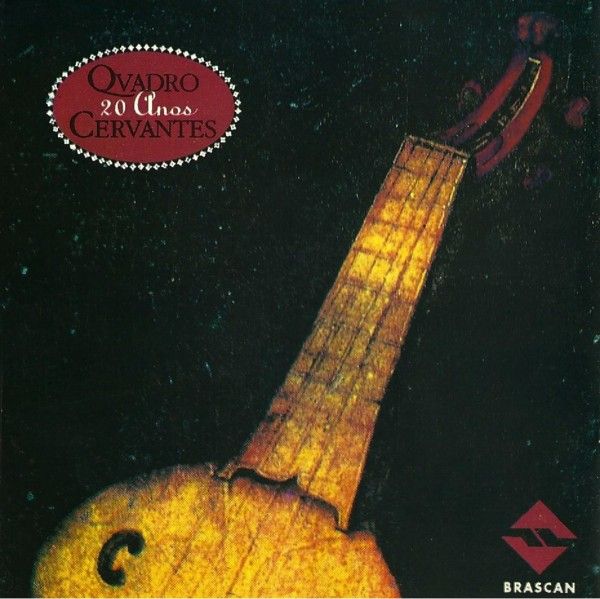20 Anos
Qvadro Cervantes

Brascan
1994
CANTIGAS DE SANTA MARIA Anônimo
1. Des oje mais [1:38]
CSM 1 —
vozes, fídula, flauta doce, sinos, percussão
2. Como poden [1:05]
CSM 166 —
fídula, flauta doce, organistrum, percussão
3. Maravillosos [2:14]
CSM 139 —
voz, flautas doces, fídula
4. Gran dereit' [3:48]
CSM 56 —
vozes, flauta doce, fídula, castanhola
5. A Madre de Deus [1:03]
CSM 24 —
flauta doce, fidula, organistrum, percussão
MUSICA DE DANZA Anônimo
6. Nota I [0:49] |
7. Nota II [1:00] —
dois pífaros, percussão
LLIBRE VERMELL Anônimo
8. Mariam Matrem [2:31]
LV 8 —
voz, harpa, flauta doce, fídula
CANCIONEIRO DO PALÁCIO,
FRANCISCO DE LA TORRE (SÉC XV)
9. Danza alta [1:51] —
flauta doce, violas da gamba, percussão
CANCIONEIRO DE MEDINACELI
10. Claros e frescos rios [2:05] —
vozes, viola da gamba, alaúde
JUAN DEL ENCINA (1468-1529)
11. Oy comamos [1:14] —
vozes, alaúde, castanholas
ALONSO DE MUDARA (1510-1580)
12. Triste estaba el Rey David [1:53] —
voz, alaúde
13. Fantasia [2:00] —
alaúde
ROMANCES Y LETRAS A 3 VOCES Anônimo
14. Siete años de pastor [2:54] —
voz, alaúde
CANÇÕES SEFARADITAS Anônimo
15. Una matica de ruda [2:50] —
voz, alaúde, flauta doce, fidula, percussão
16. Los bilbilicos [3:34] —
voz, alaúde, flauta doce
17. Tres hermanicas [2:28] —
vozes, alaúde
18. Noches, noches [2:51] —
voz
19. En la mar [1:34] —
vozes, alaúde, saltério
20. Hija mia, y casar te quiero yo [1:28] —
vozes, percussão
21. Adios querida [3:28] —
vozes, alaúde, flauta doce
22. A la una [2:21] —
vozes, alaúde, flauta doce, castanholas
ANTONIO DA SILVA LEITE (1759-1833)
23. Amor condeceu-m'um prêmio [2:27] —
vozes, flauta transversal, violão
MARCOS PORTUGAL (1762-1830)
24. Si dos males [2:14] —
vozes, flauta transversal, violão
25. Voce trata amor em brinco [3:30] —
vozes, violão
Pe. JOSÉ MAURÍCIO (1767-1830)
26. No momento da partida [2:36] —
voz, violão
C.A.G. VILLELA (SÉC XIX)
27. O velludo [2:13] —
flauta transversal, violão
MAZARINO LIMA (SÉC XIX)
28. Chegou! Chegou? [3:20] —
flauta transversal, violão

O QUADRO CERVANTES é considerado pela critica especializada como o melhor
conjunto brasileiro de música antiga medieval, renascentista e barroca.
A excelência do conjunto tem inspirado compositores contemporâneos, que
a ele dedicaram inúmeras peças.
Responsável pela formação de uma
geração de músicos, os integrantes do QUADRO CERVANTES têm sido
convidados a lecionar e apresentar-se por todo o Brasil. Merece destaque
a sua atuação frequente em concertos didáticos, que contribuem para a
formação de novas plateias.
Ao longo de sua existência, o QUADRO
CERVANTES mudou seus músicos, mas não seus ideais. Atualmente
integram-no:
· CLARICE SZAJNBRUM (voz e percussão),
· VERUSCHKA BLUHM MAINHARD (flautas, voz e percussão),
· NICOLAS DE SOUZA BARROS (alaúde, harpa, saltério, fídula, voz e percussão) e
· HELDER PARENTE (voz, sopros, viola da gamba e percussão).
A essa qualidade e a esses ideais a Brascan se associa na
gravação deste disco comemorativo dos vinte anos do
QUADRO CERVANTES.
GRAVADO INTEIRAMENTE EM DIGITAL (DDD) NO DRUM STUDIO,
EM AGOSTO E SETEMBRO DE 1994, ANO DO SENHOR.
DDD RECORDING MADE AT DRUM STUDIO IN
AUGUST/SEPTEMBER OF THE YEAR OP THE LORD 1994
ENGENHEIROS DE GRAVAÇÃO / RECORDING ENGINEERS:
Celso Junto e Alexandre Hang
PRODUÇÃO MUSICAL E DIREÇÃO DE ESTÚDIO /
MUSICAL PRODUCTION AND STUDIO DIRECTOR:
Mario Jorge Passos
ASSISTENTE DE ESTÚDIO / STUDIO ASSISTANT:
Ricardo Gaudenz
EDIÇÃO E MASTERIZAÇÃO DIGITAL / EDITING AND DIGITAL MASTER:
Celso Junto e Mario Jorge Passos
PRODUÇÃO EXECUTIVA / EXECUTIVE PRODUCTION:
Gaby Leib Produções Culturais |
Tema Eventos Culturais
PROJETO GRÁFICO / GRAPHIC DESIGN:
Silvia Steinberg |
Marcellus Schnell
TRADUÇÃO PARA O INGLÊS / ENGLISH TRANSLATION:
Antonio C. Marinho Nunes
EDITORAÇÃO ELETRONICA / ARTWORK:
Alcino Demby
FOTOLITO / COLOR SEPARATION:
Art Cor
IMPRESSÃO / PRINTED BY Graphos
CAPA / COVER H. BALDUNG GRIEN (1476-1545):
La armonia o las tres Gracias (detalhe viola / viola detail) |
Museo del Prado / Prado Museum
Agradecemos a Lenora Pinto Mendes o empréstimo da harpa, a Laura Ronái a flauta de 1903 e a George Kelischek a presteza com que nos supriu com o organistrum.
We thank Lenora Pinto Mendes for the loan of the harpa, Laura Ronái for the 1903 flute; and George Kelischek for the dispatch with which he dispatched the organistrum.
English liner notes

NOTAS AO PROGRAMA
As
CANTIGAS DE SANTA MARIA, além de serem dos primeiros documentos
musicais da peninsula ibérica, têm também grande importância pela
quantidade de iluminuras apresentando os instrumentos conhecidos no
século XIII, O rei Afonso X 'O Sábio' (1221-1284) soberano de Castela e
Léon, grande devoto da Virgem Maria, mandou compilar mais de 400 canções
de louvor vie descrevem milagres ocorridos por intermédio da mãe de
Jesus. Nos 4 manuscritos que são conhecidos atualmente, mais de 350
destas canções estão em galego, dialeto que deu origem ao português.
Algumas estão grafadas em notação mensurada, o que permite uma
transcrição clara e definida sob o aspecto rítmico.
O LLIBRE
VERMELL (Livro Vermelho) contêm peças musicais de caráter popular
praticadas pelos fiéis em peregrinação à abadia de Montserrat e foi
copiado em fins do século XIV ou princípio do século XV. No último terço
do século XIX foi encadernado em veludo vermelho, originando sua
denominação. Além de canções e danças de culto monofônicas, contém os
primeiros exemplos de polifonia dos quais Mariam Marrem é, sem dúvida, o mais sofisticado.
As
NOTAS são música de dança, menos complexas e menos extensas que os
ductios e os estampidos. Os dois exemplos provem de manuscrito, hoje na
British Library. O primeiro é composto de três frases melódicas
repetidas na voz inferior segunda, enquanto a superior executa um
contraponto continuamente diferenciado. O segundo exemplo tem duas
frases, a princípio apresentadas na voz inferior e depois, na superior
transposta uma quinta acima.
A Danza Alta, em oposição à
dança baixa, exige grande disposição dos dançarinos em virtude dos
saltos que a caracterizam, A peça de F. de la Torre (Cancioneiro do Palácio) apresenta uma melodia ricamente ornamentada com o suporte de duas vozes acompanhantes,
Triste Estaba el Rey David
— A. Mudarra. Nesta pungente peça, o famoso vihuelista narra a tristeza
do rei David ao saber da morte de seu querido filho Absalão, conforme
narrada em II Samuel, 18:33.
Triste estaba el rey David
cuando le vinieron nuevas
de la muerte de Absalon.
Palavras tristes decia
alidas del corazón.
Fantasia que Contrahaze la Harpa de Ludovico
— O harpista Ludovico era cego, e gozava de prestígio entre os
vihuelistas espanhóis de então, justamente porque conseguia 'semitonar'
as cordas do seu instrumento através de uma técnica especial.
Entre
as coleções espanholas de música polifônica profana dos séculos XV e
XVI destacam-se, pela qualidade do material nelas contido, o CANCIONEIRO
DO PALÁCIO e o de MEDINACELI. O repertório destas coleções é
basicamente vocal e com textos em espanhol, em sua maioria.
De uma coleção do século XVII, ROMANCES Y LETRAS A
3 VOCES, provém uma versão musicada em espanhol do famoso
soneto de Camões Sete anos de pastor.
Em
1492 Suas Majestades Católicas, Fernando e Isabel, houveram por bem
expulsar da Península Ibérica uma enorme população de judeus por razões
pretensamente religiosas. Estes judeus, que se encontravam desde a
invasão árabe em perfeita convivência com ambas as culturas, a católica e
a islâmica, são chamados de sefaraditas (em hebraico Sefared significa
Espanha) e falam uma língua judaico-espanhola própria, o ladino (do
espanhol latin). Nas novas terras onde aportam, mantêm alguns traços
culturais que se transmitem até nossos dias pela tradição oral, tais
como língua e canções. Extremamente difícil de serem datados, alguns
destes cantos de amor, religiosos, de zombaria, são considerados por
especialistas como anteriores à data da expulsão. Merece registro a
semelhança da melodia de Adios querida com a aria do quarto ato da Traviata de Verdi, "Addio del passato".
Publicadas originalmente pelo "Jornal de Modinhas", que funcionou de 1792 a 1795 em Lisboa, or duos Amor concedeu-m'um prêmio de Antonio Silva Leite, Se dos males e Voce trata amor em brinco de Marcos Portugal mostram, junto com No momento da partida
do Pe. José Maurício, a influência do gosto musical itatiano,
maltratando a língua portuguesa pelos frequentes problemas de prosódia
que apresentam.
O Velludo e Chegou! Chegou? são
peças publicadas para piano no início de nosso século que, por sua
estrutura de melodia acompanhada, nos sugeriram a versão que
apresentamos para flauta e violão. A primeira possui uma dedicatória "ao
distinto flautista paulista João de Oliveira Duarte", e a segunda é uma
polka sobre o motivo da cançoneta Chegou! Chegou? cantada no Theatro
Apollo poi. Mr. Visconti.
INSTRUMENTOS E ESTILOS
No
começo era a diversidade, a multiplicidade, a riqueza: o mesmo som
poderia ser reproduzido por instrumentos com formas completamente
diferentes, mantendo-se os mesmos princípios de produção sonora — cordas
friccionados ou tangidas, sopros de embocadura livre on não, palheta
simples ou dupla etc.
O começo da padronização instrumental
acompanha o advento da imprensa (início do século XVI) quando surgem os
primeiros tratados gerais de música o métodos para instrumentos. Assim,
começamos a poder reconhecer instrumentos que, apesar de tamanhos
diferentes, são classificados como pertencentes a uma mesma família, com
o mesmo timbre em registros diferentes (ex: viola da gamba baixo, tenor
e soprano em ordem decrescente).
Paralelamente a esta
padronização ocorrem mudanças na escrita e na linguagem musical. A um
modelo anterior que seria a melodia sozinha executada, por exemplo, com
voz humana e flauta doce acompanhados por pedal (fídula) e percussão
acrescentam-se linhas acompanhantes que se movem em blocos verticais,
servindo de colunas de sustentação para a melodia (harmonia), podendo
ter movimentos independentes (contraponto).

PROGRAM ANNOTATIONS
Besides being the earliest extant musical documente from the Iberian Peninsula, the CANTIGAS DE SANTA MARIA
(Saint Mary Songs) are all the more important in that they contain a
treasure-trove of illuminations depicting the instruments known in the
XIIIth century. Alphonse X "The Wise" (1221-1284), king of Castille and
Leon and very much devoted to the Virgin Mary, had over 400 laudatory
songs compiled proclaiming the miracles obtained through the mediation
of the Mother of Jesus. In the 4 known manuscripts today, over 350 such
songs are in Galician, the dialect which gave
birth to the Portuguese language.
The LLIBRE VERMELL
(The Red Book), copied at the end of the XIVth century or the beginning
of the XVth, compiles music pieces of a popular vein usually played by
the faithful on their pilgrimage to the Monserrat Monastery. In the last
third of the XIXth century it was bound in red velour, hence its name.
Other than songs and dances performed in monodic church services, it
contains the first examples of Iberian polyphony of which Mariam Matrem is undoubtedly the most sophisticated.
The NOTAS
(Notes) are dance music less complex and shorter than the medieval
ductias or estampies. The two pieces come from the manuscript kept today
in the British Library. The first is composed of three melodic lines,
the second repeated in the bottom voice while the top voice executes a
continuously differentiated counterpoint. The second piece is made of
two musical phrases first played in the bottom voice and later in the
upper transposed upwards by one fifth.
The Danza Alta
(High Dance), as opposed to the low dance, demands a certain amount of
effort from the dancers because of the frequent leaps that characterize
it. F. de la Torres piece — CANCIONEIRO DO PALÁCIO — presents a melody richly ornamented with the support of two accompanying voices.
Triste Estaba el Rey David (Sadness overwhelmed King David) — A. Mudarra. In this pungent piece the famous vihuela player recounts King David's sadness upon learning of his beloved son Absalom's death as told in II Samuel, 18:33:
Sadness overwhelmed King David
as news was brought to him
of Absalom's death.
Grief-laden words gushed
straight from the heart.
Fantasia que Contrahaze la Harpa de Ludovico (Fantasia that imitates Ludovico's harp). Ludovico was a blind harpist much admired by the Spanish vihuela players of the time for his special technique in playing the instrument.
Among
the group of profane Spanish polyphonic music from the XVth and XVIth
centuries, the following are noted for the quality of the material
presented: O CANCIONEIRO DO PALÁCIO and O CANCIONEIRO DE MEDINACELI.
From Romances y Letras a 3 Voces
(Romances and Words for 3 voices), a collection from the XVIIth
century, comes a Spanish musical version of Camões' famous sonnet Sete Anos de Pastor (Seven Years a Shepherd).
Their
Catholic Majesties Fernando and Isabel, under the false pretense of
religious considerations, decided in 1492 to expel from the Iberian
Peninsula an enormous Jewish population. Those Jews who ever since the
Arab invasion lived in harmony with both the Christian and Arabic
cultures are known as Sephardim (in Hebrew, Sephard is the name for
Spain), their tongue — the Ladino, from Latin in Spanish — their
own mix of Spanish and Hebrew. To the new lands in which they settled
they brought some cultural traits that are transmitted to the present
via oral traditions embodied in the language and songs. Extremely
difficult to be dated, some of such love, religious or mocking songs are
considered by specialists to precede the time of the banishment. To be
noted, is the similarity between the melody Adios Querida (Good bye my Darling) and the fourth act aria of Verdi's Traviata "Addio del passato."
Originally
published in the Jornal de Modinhas (Song Journal) that circulated in
Lisbon in the years 1792-1795, the duos Antonio Silva Leites Amor concedeu-m'um prêmio (Love has awarded me a prize) and Marcos Portugal's Se dos males (Whether from ills) and Você Trata Amor em Brinco (You Treat Love in a light-hearted manner) together with Father José Mauricio's No momento da partida
(At the time of departure) show the influence of the Italian musical
taste in abusing the Portuguese language as evidenced by frequent
prosody transgressions.
O Velludo (Velour) and Chegou! Chegou?
(Has arrived! Has arrived?) are piano pieces published at the beginning
of the century which, due to their accompanied melodic structure,
suggested the version presented for flute and guitar. The first bears a
dedication to the eminent flutist from São Paulo, João de Oliveira
Duarte"; the second is a polka on the motif of the little tune Chegou!
Chegou? sung by Mr. Visconti in the Apollo Theater.
INSTRUMENTS AND STYLES
In
the beginning there reigned diversity, multiplicity and richness: the
sound could be played by instruments totally different in form in
observance of the same principles of sound generation — plucked or
grated strings, winds of different mouthpieces, simple or double reeds,
etc.
The beginnings of instrumental standardization coincide with
the advent of the printing press (early XVIth century) when the first
general music treatises and instrumental methods made their appearance.
It thus becomes possible to recognize instruments which despite their
different sizes are nonetheless classified as belonging to the same
family, producing the same tone color in different registers (for
instance, bass viola da gamba, tenor and soprano in decreasing order).
In
parallel with this standardization there occur changes in the musical
language and its notation. Thus, to an earlier model which might be a
single melody executed, say, by the human voice and recorder accompanied
by a pedal (fistula) and percusion, lines are added which move in
vertical blocks by way of supporting columns to the melody (harmony) and
capable of having independent movements (counterpoint).
QUADRO CERVANTES is considered by music critics as the best Brazilian
ensemble interpreting the medieval, renaissance and baroque repertoires.
Their excellence has inspired contemporary composers to dedicate to
them many of their works. They have been responsible for the education
of a whole generation of musicians and have been invited to lecture and
play throughout Brazil. Of special note is their frequent appearance in
didactic performances that contribute to the formation of a new public.
Over
the years, QUADRO CERVANTES has changed its musicians, never its
ideals. Presently, the group is formed by the following artists: CLARICE SZAJNBRUM (voice and percussion), VERUSCHKA BLUHM MAINHARD (flutes, voice and percussion), NICOLAS DE SOUZA BARROS (lute, harp, psaltery, fídula, voice and percussion) and HELDER PARENTE (voice, winds, viola da gamba and percussion).
Brascan
associates itself to this quality and these ideals in the production of
this recording which celebrates the twentieth anniversary of QUADRO
CERVANTES.



